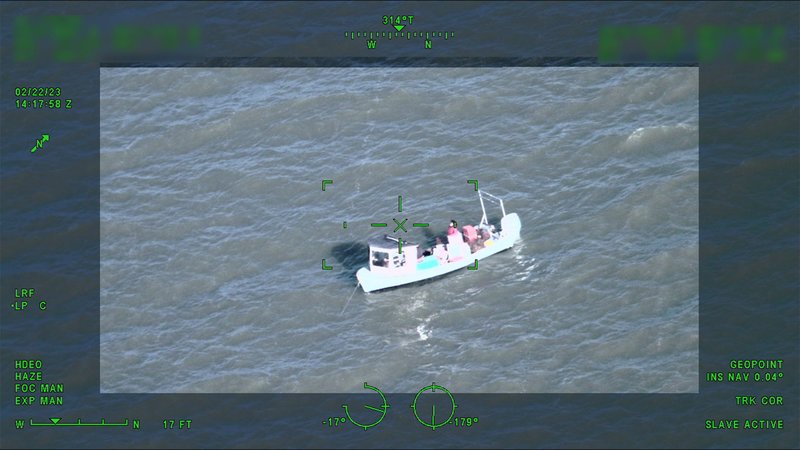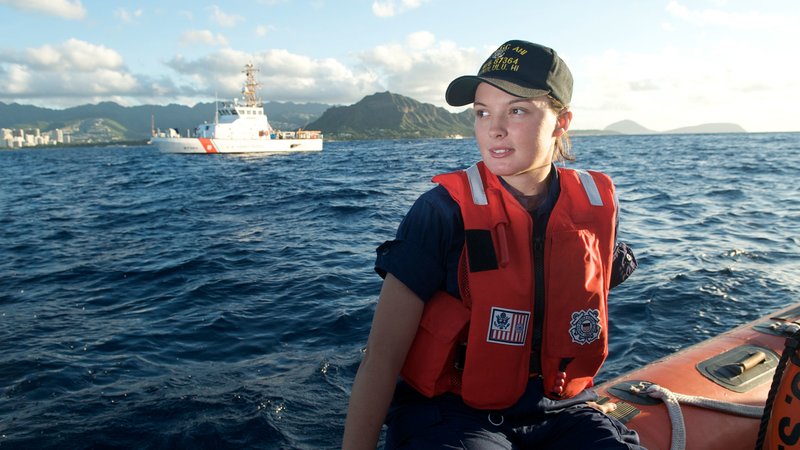
Coast Guard boot camp recruits shout a response to their company commander at Coast Guard Training Center Cape May, New Jersey, May 18, 2022. US Coast Guard photo by Public Affairs Specialist 1st Class Lisa Ferdinando.
The United States Coast Guard is a branch of the military. Read that again: The Coast Guard is a branch of the military.
Just like soldiers, sailors, Marines, airmen, and Guardians, the people who serve in the Coast Guard are service members. They wear uniforms, eat in mess halls, and do fun stuff like wake up before the crack of dawn and occasionally run in formation. They even attend basic training. Yep, that’s right. Coast Guard boot camp is a real thing.
If this is all news to you, you might now be wondering what recruit training is like for Coasties. How is one initiated into the profession of protecting America’s shores? Well, don’t worry. Coffee or Die is here to tell you.
First, it might help to know what the Coast Guard does.
As the maritime security, search and rescue, and law enforcement branch of the US Armed Forces, the Coast Guard is the only service that falls under the Department of Homeland Security. Its mission ranges from intercepting foreign nationals attempting to illegally enter the US by water to rescuing people stranded at sea to fighting illegal fishing.

The Coast Guard rescued three overdue boaters Wednesday, Feb. 22, 2023, near Breton Sound, Louisiana. US Coast Guard photo.
The second-smallest military branch — only larger than the still-growing 16,000-member Space Force — the Coast Guard offers 28 different enlisted and officer ratings (or jobs) to its approximately 47,000 personnel. Regardless of their rating, every Coast Guardsman works to support the branch’s five main missions: “maritime security, maritime mobility, maritime safety, protection of natural resources, and national defense.”
Not everyone who joins the Coast Guard enters the ranks in the same way. Future officers are trained and educated at the United States Coast Guard Academy in New London, Connecticut. Recruits with prior military service, or qualifying civilian work experience, attend a truncated version of basic training called the 20-day Direct Entry Petty Officer course.
As for everyone else — i.e., run-of-the-mill enlistees — the journey begins with eight unforgettable weeks in Cape May, New Jersey.
Related: A Brief — but Impressive — History of the US Coast Guard

Yeoman 3rd Class Stephanie Kerley stands in front of Sexton Hall at Training Center Cape May, N.J., Tuesday, April 7, 2015. Kerley works in the center’s servicing personnel office, where yeomen issue identification cards and process recruits through enlisted basic training. US Coast Guard photo by Public Affairs Specialist 3rd Class David Micallef.
You Must Be This Old To Ride
Not everyone can sign up to become a certified “Puddle Pirate.” There are prerequisites. For example, as with all the other service branches, Coast Guard enlistees must be US citizens or resident aliens. They also must be at least 17 years old. The maximum age to enlist in the Coast Guard used to be 35, but in November 2022 it was raised to 42.
The recent increase in the maximum enlistment age means that the Coast Guard now accepts the oldest recruits of any US military branch. According to Master Chief Sean Smith, battalion commander of Training Center Cape May, changing the age limit was a way of “removing another barrier” to enlistment and allowing a broader swath of the American population to serve in the Coast Guard.
“One thing that we’re really looking to do is build a more inclusive and diverse culture here,” Smith told Coffee or Die. “Where everybody feels valued, respected, and encouraged to contribute to their fullest potential and to feel a connection to our mission.”
A person interested in joining the Coast Guard would first need to connect with a recruiter so they can begin the screening process. If you are having trouble finding your local Coast Guard recruiter, try harder. They are easy to find.

Representatives from all service branches on the Council on Recruit Basic Training tour facilities at US Coast Guard Training Center Cape May in New Jersey, May 11, 2022. US Coast Guard photo by Chief Warrant Officer 2 Timothy Tamargo.
All volunteers must take and pass a physical fitness test. Men must complete 29 pushups in one minute, 38 situps in one minute, and a 1.5-mile run in under 12 minutes and 52 seconds. Women must complete 15 pushups in one minute, 32 situps in one minute, and a 1.5-mile run in 15 minutes and 26 seconds or less. Both men and women must also jump off a 6-foot platform into the water and be able to swim 100 meters unassisted and tread water for five minutes. The Coast Guard offers remedial physical training for prospective recruits who are initially unable to meet the standards.
Related: Coast Guard Arctic Rescue: Garbage Weather, Sharks, a Murderous Bear, and a Baby To Save
‘High Winds and Really Cold Temperatures’
The sole location for Coast Guard boot camp is the Coast Guard Training Center in Cape May, New Jersey. There, in the “Coast Guard’s hometown,” over 4,000 aspiring Coasties begin the next chapter of their lives each year.
“We have a wide range of weather here,” Smith said. “We get a lot of ‘good Coast Guard weather,’ we like to call it: high winds and really cold temperatures in the winter and really hot temperatures in the summer.”

Representatives from all service branches on the Council on Recruit Basic Training tour facilities at US Coast Guard Training Center Cape May in New Jersey, May 11, 2022, to address common issues across the joint services in recruit basic military training. US Coast Guard photo by Chief Warrant Officer 2 Timothy Tamargo.
Upon arrival, recruits are greeted by their company commanders. Similar to drill sergeants in the other branches, the company commanders at Cape May are responsible for transforming fresh volunteers into bona fide Coasties — or, as Cape May spokesperson Public Affairs Specialist 2nd Class Shannon Kearney put it, into “smartly disciplined, physically fit, basically trained Coast Guard women and men who are prepared to deploy for world-wide assignment.”
There are typically three to four commanders per company. Each is trained and prepared to manage up to 120 recruits on their own. According to Kearney, the training companies are usually larger in summer and fall than they are in winter and spring.
What It’s Like
The first moments after a new recruit has received their gear, gotten their hair cut, and been ordered to hold their bags above their heads by a pack of rabid drill sergeants have been depicted in countless films and television shows.
For Coasties, however, the Day Zero initiation — the “shark attack,” the “get off my bus!” and the PT session that doesn’t end until the walls sweat — doesn’t set the tone for the next eight weeks (as it often does in, say, the Army or Marine Corps). Because new recruits are sent straight to the fleet after graduating boot camp, the company commanders’ primary objective is to ensure trainees leave Cape May prepared to do their jobs.

Seaman Tessie Lee, stationed on board the 87-foot Coast Guard cutter Ahi, is responsible for assisting boatswain’s mates in maintaining the ship and line handling while mooring and getting underway. US Coast Guard photo by Public Affairs Specialist 1st Class CC Clayton.
Which is not to suggest that Coast Guard boot camp is a cakewalk. Getting yelled at and doing painful amounts of exercise are certainly part of the experience, but recruits might find themselves disappointed if they show up hoping for the Full Metal Jacket treatment.
“What we do is stressful,” Smith said. “Nobody calls for us to come and help them when it’s flat seas and nice weather. We go out at the worst. We have to have a stressful program here to evaluate their stress and make sure they can handle it.”
According to Smith, company commanders follow a five-phase training method based on Tuckman’s Stages of Group Development. During the first phase, recruits are conditioned to be obedient and responsive to orders. They are also taught how to walk, talk, and carry themselves like Coasties.
Teamwork and discipline are the focus of phase two. Additionally, recruits are familiarized with Coast Guard rules and regulations and basic military skills and knowledge. During the third phase, recruits continue to develop their basic military skills and knowledge, with an emphasis on individual accountability and team building. They do early morning workouts, drill exercises, and eventually meet their company mentor, a Coast Guard member currently in the fleet who talks to them about what their career in the military will entail.
The Coast Guard does not require its recruits to pass a weapons qualification course to graduate. However, they are trained to use rifles, shotguns, pistols, and certain mounted machine guns. They are also made to fight each other with pugil sticks, an experience meant to prepare them for hand-to-hand combat and boost their confidence as they enter the fleet.

Members of Coast Guard Recruit Company Zulu 186 conduct pugil stick training at Training Center Cape May on Aug. 2, 2012. US Coast Guard photo by Chief Warrant Officer Donnie Brzuska.
The final two phases are condensed into week seven. This is the time when recruits are expected to perform all the skills and core competencies they have been trained on so far. The assessment includes a final test as well as a challenging obstacle course.
The last week of training, which Smith called the “adjourning phase,” culminates in a graduation ceremony for the recruits who managed to pass and will spend their Friday morning marching for their friends and family to see and celebrate with them.
“We have 184 enlisted performance qualifications that we actually train them while they’re here, and they all meet all 184 [of] those standards,” Smith said. “So every week when we send graduates, seamen and firemen, out to the Coast Guard, we know that they’ve all met those 184 requirements, and then obviously been instilled discipline, responsibility and live our core values of honor, respect, and devotion to duty.”
Related: How This Coast Guard Crew Saved a Canadian Skipper and 2 Dogs
Time To Get To Work
Unlike the military branches that fall under the Department of Defense, the Coast Guard sends boot camp graduates straight to the operational fleet as nonrates – the service’s E-1 and E-2 rankings. Only about 10% of graduates know what rating or job they’ll hold after boot camp, and the other 90% are assigned to be either seamen or firemen.

A rescue swimmer with Coast Guard Air Station Kodiak, Alaska, Coast Guard Aviation Survival Technician 1st Class Rafael Aguero carries Grace, an 8-month-old puppy presumed lost after her owner's vessel ran aground near Black Point on Nov. 1, 2021, and returns her home. US Coast Guard photo.
The Coast Guard’s area of responsibility covers nine districts throughout the US and its territories, and there are several different duty stations within each district. Coasties graduating boot camp can request specific assignments, but ultimately it’s not up to them to decide where they end up. Some might get orders to, say, Louisiana or Ohio; others to far-flung places like Guam or the Alaskan hinterlands.
According to Smith, nonrates serve in a variety of roles. They might be assigned to a boat, to a Coast Guard station, or to a shore-based operational unit called a “sector.” In other words, a career in the Coast Guard can entail a wide array of experiences. There are the quiet assignments that Mom would approve of and then there are the places where the action never stops — the places where doing stuff like rescuing people from hurricane-ravaged islands or swimming in shark-infested waters is just another day on the job.
Read Next: ‘I Just Disobeyed the Order’: The Incredible Story of Capt. Paris Davis’ Medal of Honor

Noelle is a former staff writer for Coffee or Die through a fellowship from Military Veterans in Journalism. She has a bachelor’s degree in journalism and interned with the US Army Cadet Command. Noelle also worked as a civilian journalist covering several units, including the 75th Ranger Regiment on Fort Benning, before she joined the military as a public affairs specialist.
BRCC and Bad Moon Print Press team up for an exclusive, limited-edition T-shirt design!
BRCC partners with Team Room Design for an exclusive T-shirt release!
Thirty Seconds Out has partnered with BRCC for an exclusive shirt design invoking the God of Winter.
Lucas O'Hara of Grizzly Forge has teamed up with BRCC for a badass, exclusive Shirt Club T-shirt design featuring his most popular knife and tiomahawk.
Coffee or Die sits down with one of the graphic designers behind Black Rifle Coffee's signature look and vibe.
Biden will award the Medal of Honor to a Vietnam War Army helicopter pilot who risked his life to save a reconnaissance team from almost certain death.
Ever wonder how much Jack Mandaville would f*ck sh*t up if he went back in time? The American Revolution didn't even see him coming.
A nearly 200-year-old West Point time capsule that at first appeared to yield little more than dust contains hidden treasure, the US Military Academy said.












